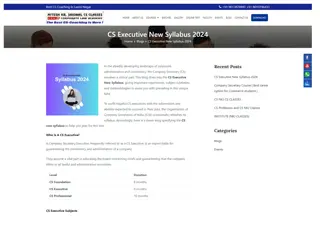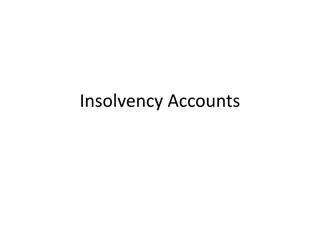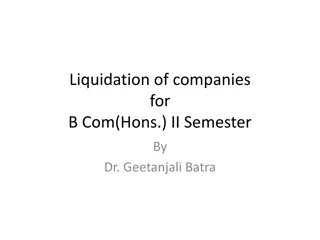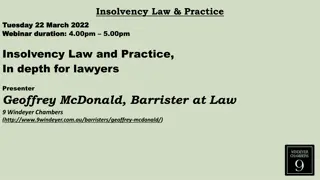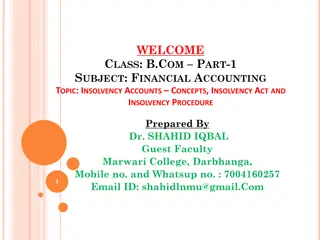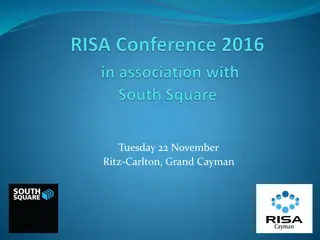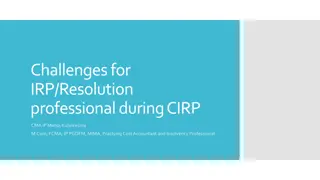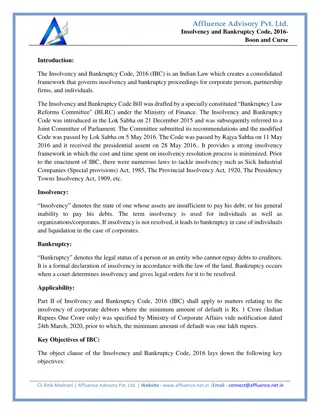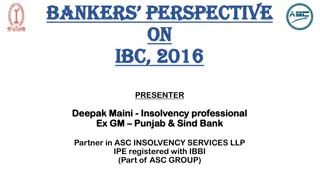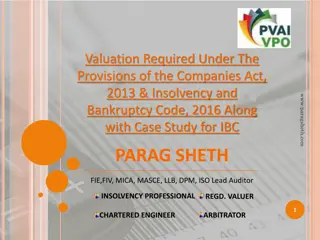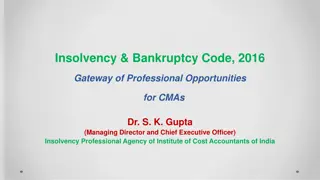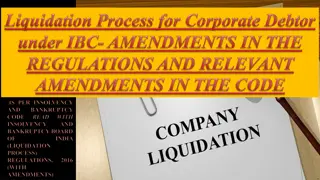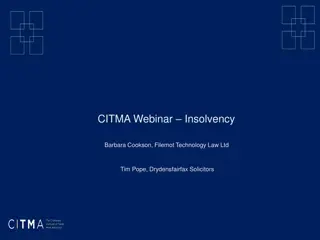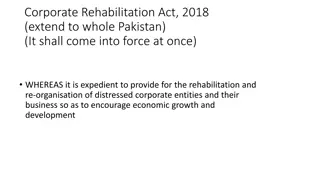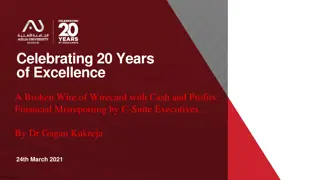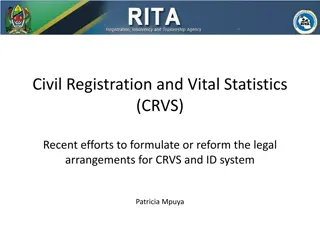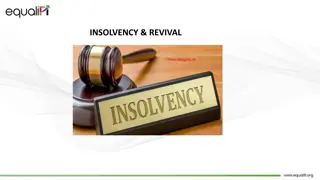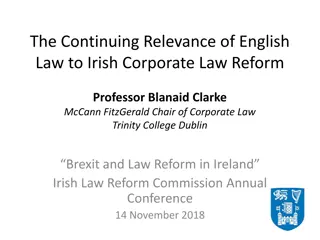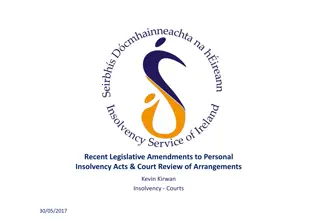Understanding US Corporate Reorganizations and Insolvency Law
Explore the key players in the US bankruptcy system, including bankruptcy judges, Debtors-in-Possession, and Creditors Committee in Chapter 11. Learn about basic bankruptcy concepts such as claims and priority, and the priority scheme outlined in the Bankruptcy Code. Gain insights into the legal obligations of debtors and the management of bankruptcy estates.
Download Presentation

Please find below an Image/Link to download the presentation.
The content on the website is provided AS IS for your information and personal use only. It may not be sold, licensed, or shared on other websites without obtaining consent from the author. Download presentation by click this link. If you encounter any issues during the download, it is possible that the publisher has removed the file from their server.
E N D
Presentation Transcript
Introduction to Law of U.S. Corporate Reorganizations Insolvency Professional Agency of Institute of Cost Accountants of India February 2019 Prof. C. Scott Pryor Fulbright-Nehru Research Scholar at National Law University, Delhi Professor of Law at Campbell University School of Law, Raleigh, NC, USA
Personages in US Bankruptcy System 1. Bankruptcy Judge Part of the federal judiciary Not part of companies/corporate law administration (not NCLT) 2. Debtor-in-Possession in Chapter 11 Management of pre-bankruptcy debtor remains in control of its assets and continues to run its business after filing Chapter 11 (Bankr. Code 1107(a)) Has most of the powers of a liquidation trustee (Bankr. Code 1108) Has fiduciary duties to the bankruptcy estate and may be sued by creditors for violation of the duties of care and loyalty May be replaced by Bankruptcy Court with a managing trustee (similar to RP) but only for fraud or gross incompetence o o 2
Personages in the Bankruptcy System 3. Creditors Committee in Chapter 11 As soon as practicable after filing, a committee of unsecured creditors shall be appointed Typically seven members drawn from volunteers among unsecured creditors holding 20 o largest claims Empowered to investigate, negotiate, and advocate on behalf of all unsecured creditors Expenses of members paid by estate With approval from the Bankruptcy Court, Committee may retain its own legal counsel and accountants who will be paid by the DIP 3
Basic Bankruptcy Concepts 3. 3. CLAIMS AND PRIORITY CLAIMS AND PRIORITY 1. What Is a Claim? Bankr. Code 101: (5) The term claim means (A) right to payment, whether or not such right is reduced to judgment, liquidated, unliquidated, fixed, contingent, matured, unmatured, disputed, undisputed, legal, equitable, secured, or unsecured All legal obligations of the debtor, no matter how remote or contingent, will be o able to be dealt with in the bankruptcy case. It permits the broadest possible relief . . .. (H.R. Rep. No. 595, 95th Cong., 1st Sess. 180 (1977)) 4
Basic Bankruptcy Concepts 3. 3. CLAIMS AND PRIORITY (WATERFALL) CLAIMS AND PRIORITY (WATERFALL) 3. Basic Priority Scheme Bankr. Code 507(a): The following expenses and claims have priority in the following order: (1) Administrative expenses (4) Wages (5) Employee benefits ... (7) Certain taxes 5
Corporate Reorganization 1. 1. Life Cycle of Corporate Chapter 11 Life Cycle of Corporate Chapter 11 1. 2. 3. 4. 5. 6. 7. 8. 9. 10. Post-Confirmation What Must Be Filed Rights, Powers, and Duties of a Debtor-in-Possession Cash Collateral and Debtor-in-Possession Financing Sales Outside Ordinary Course of Business Plan of Reorganization Disclosure Statement Classification of Claims and Voting Confirmation of Plan Cram-Down of Plan 6
Corporate Reorganization 2. 2. Life Cycle of Corporate Chapter 11 Life Cycle of Corporate Chapter 11 1. Rights, Powers, and Duties of a Debtor-in-Possession Bankr. Code 1107(a): DIP has all the rights and powers, and shall perform all the functions and duties of a trustee If DIP fails to take seriously its fiduciary obligations, creditors may seek appointment of a managing trustee (RP) If management of DIP violates its fiduciary duty of loyalty, creditors or subsequent liquidation trustee may sue for damages 7
Corporate Reorganization 6. 6. Life Cycle of Corporate Chapter 11 Life Cycle of Corporate Chapter 11 1. Plan of Reorganization Bankr. Code 1123 (a) The plan shall address 8 mandatory matters (b) The plan may provide for 6 permissive matters (in fact, Bankruptcy Courts have allowed plans to address more than the permissive items listed in the statute) What Is a Plan? A plan is a an agreement between the DIP, its creditors, and its equity holders that provides terms for emergence from bankruptcy, including treatment of their respective claims and interests o 8
Corporate Reorganization 6. 6. Life Cycle of Corporate Chapter 11 Life Cycle of Corporate Chapter 11 3. Plan of Reorganization Process and Procedure Core issue is usually cash flow: The troubled company s cash flow is too small to service debt and pay variable (costs of goods sold) plus fixed (overhead) obligations How does Chapter 11 address this issue? Excess expenses, such as leases and losing contracts are addressed during the case by rejection Plan of Reorganization looks to restructure debt service o o 9
Corporate Reorganization 6. 6. Life Cycle of Corporate Chapter 11 Life Cycle of Corporate Chapter 11 4. Plan of Reorganization Process and Procedure Core issue is usually cash flow Bankruptcy cannot grow money! The final question: Can the restructured debtor make its anticipated net revenues cover the new debt service? o o 10
Corporate Reorganization 7. 7. Life Cycle of Corporate Chapter 11 Life Cycle of Corporate Chapter 11 4. Classification of Claims and Voting Bankr. Code 1126(c): a class of claims has accepted a plan if creditors that hold at least in amount, and o > in number o vote to accept the plan 11
Corporate Reorganization 8. 8. Life Cycle of Corporate Chapter 11 Life Cycle of Corporate Chapter 11 1. Confirmation of Plan Bankr. Code 1129(a): The court shall confirm a plan only if all of the following requirements are met: (7) With respect to each impaired class (A) Each holder of a claim has either (i) accepted the plan or (ii) will ultimately receive under the plan payments the present value of which is at least as much as it would have received under a Chapter 7 liquidation [the best interests test] Proof that payments under plan > liquidation value requires evidence from cost accountants and valuators 12
Corporate Reorganization 8. 8. Life Cycle of Corporate Chapter 11 Life Cycle of Corporate Chapter 11 11. Confirmation of Plan Bankr. Code 1129(a): The court shall confirm a plan only if all of the following requirements are met: (11) Feasibility Will the restructured debtor have sufficient net income to service its restructured debt obligations? o Requires evidence from accountants and valuators o 13



